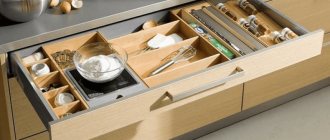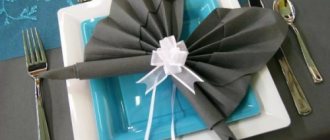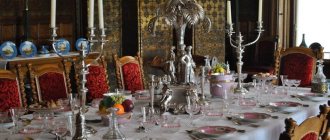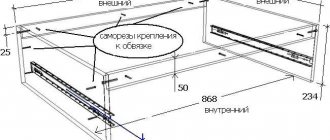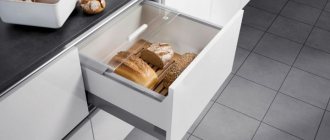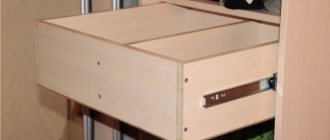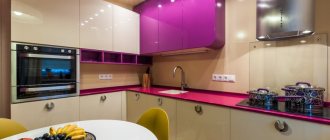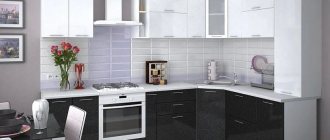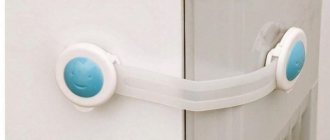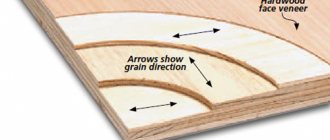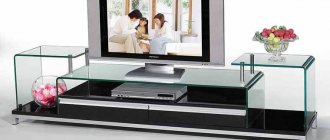Organizing a workspace in the kitchen means not only increased comfort and ease of use, but also safety. It is for this reason that it is necessary to think through every little detail, the same applies to the issue when choosing a tray for cutlery, which is most often displayed in furniture in the kitchen.
Every real housewife always has a large number of tools in her arsenal for preparing her favorite dishes and serving them.
This article will look at the basic designs of organizers, drying means used in trays and cutlery fittings. The data can be used when thinking about how to best store cutlery in the kitchen.
Features of cutlery trays in a kitchen drawer
Trays for spoons and forks are increasingly included in standard furniture. But when it is not there, you have to solve this issue yourself. because otherwise it is very inconvenient to dry and store cutlery.
The list doesn’t end with forks and spoons; brushes, tongs, corkscrews and other items also require storage space.
Today, most often there are 3 options for the location of this retractable structure:
- Top horizontal layout. In this case, the tray is located directly under the top of the drawers in the top drawer. Most often, it is made quite small in height (flat) - only a box with spoons and forks, as well as some other household appliances, can be placed in it. Thus, this arrangement does not take up useful free space.
- Lower horizontal - in this case, the drawer, including a storage structure, is located approximately at a height of 0.3-1 m from the floor. The main disadvantage is that if there are small children in the family, they can easily reach this box and take out dangerous devices.
- Vertical retractable pencil case - here you can arrange a wide variety of tools in several rows. This insert looks quite original on the external facade of kitchen cabinets.
Over the years, the number of devices has only increased, so the problem of distribution and organization is more relevant than ever.
In today's furniture, especially if it is represented by a fairly large kitchen set, there are configurations with several drawers. This allows you to conveniently arrange everything you need, carrying out the necessary sorting. So meat knives, mixer whisks, cake spoons and other rarely used tools can be stored separately (in a separate section). Whereas those that are used daily can be placed in a separate compartment.
According to its form:
- straight;
- corner;
- carousel.
Rules for organizing and storing household appliances
Ideally, it is better to have several wooden or metal cutlery trays. This point is quite easy to explain:
- Usually, owners have a number of additional tools in their arsenal for baking and preparing more complex dishes. If you lay out all the cutlery on the table, you will have to make sure that there are enough of them. If you store everything in one box, the order will be disrupted, the silicone molds will be damaged, etc.
- Accessibility – the issue here is more about the safety of children. It is advisable to place knives and sharp objects higher, in a remote compartment or in a special organizer on the countertop.
Stacked baskets are used to store molds and baking tools. If desired, you can make them yourself from thin rattan or other material. It is not advisable to use shoe boxes, as they will quickly get wet and lose their functionality.
Stacked baskets are used to store molds and baking tools.
Additionally, you can use a separator for forks and spoons in the drawer. Using such an organizer will ensure order and safety. After all, many have at least once encountered slight damage to new nail art when household members randomly start putting away cutlery.
Using such an organizer will ensure order and safety.
By the way, many dish dryers already include small compartments for storing spoons and forks. Their use turned out to be less effective. Before placing cutlery in a separate compartment, it is advisable to dry it well, which will also take time. Otherwise, the water will flow down your hands and stagnate on the box itself. The last problem can develop into damage to the coating, especially if the kitchen is made of not very high-quality material.
Many dish drainers already include small compartments for storing spoons and forks.
To store knives, mothers recommend using special magnetic rails. The headset ensures comfortable use and safety. In fact, this option has fully justified itself in that the knives are firmly fixed on the stand and it will be quite difficult for a child to reach them. Additionally, a container is used to collect moisture.
The headset ensures comfortable use and safety.
Do not exclude vertical cutlery holders in the drawer. If the module has only one storage compartment, then it is used to place spoons and forks. A vertical organizer is suitable for storing lids, massive utensils in the form of ladles, sieves, etc. It is installed on the door of one of the compartments for storing pots or other household utensils.
The vertical organizer is suitable for storing lids, massive utensils in the form of ladles, sieves, etc.
To organize devices and systematize, you can use 3 rules:
- Be sure to separate all devices into groups. Household members will quickly get used to this order, because finding a favorite spoon or fork will become much easier.
- Limit moisture - regularly drain the water from the trays and dry the appliances.
- Avoid crumbs and excess debris. Most often, unkempt pallets cause unwanted insects to appear.
Compliance with such obvious rules will help organize the room correctly. After all, only order provides additional storage space for equally important tools.
A regular solution of chlorine or cleaning agent will help get rid of the unpleasant odor of the insert.
You need to regularly drain the water from the trays and dry the appliances.
Cutlery insert materials
These products can be wooden, made of various types of plastic or stainless steel. Each material has its own distinctive features and prerogatives in use.
For example, a wooden tray may be exposed to moisture if items are placed there while they are wet.
Most often, a tray for storing cutlery and utensils is already included in the standard kitchen module.
When choosing plastic as a material, it is necessary to purchase only high-quality products, since such a tray itself can release harmful components. To avoid this drawback, it is enough to pay attention to accessories from trusted brands that do not allow themselves to use low-quality plastic.
Metal organizers are susceptible to moisture in the same way as wooden ones. Therefore, it is necessary to dry the accessories first before storing them.
Speaking of built-in drawers, most often it is located in the module itself - in a closet or pencil case.
Plastic inserts
Most often, it is plastic inserts that are used in pull-out cabinets. This is due to the fact that such a dryer is not exposed to moisture and does not allow it to pass out (if the design is made without holes). In this case, there is no negative impact on the material from which the retractable piece of furniture itself is made.
It is also worth noting that it is plastic pallets that have the most thoughtful combinations of compartments.
For ease of use, it is necessary that 1 product includes 6-8 compartments of different shapes and sizes:
- a separate, fairly large compartment for storing spoons and forks;
- a separate container for knives and other cutting and piercing products;
- a separate, small part in which dessert products, as well as tea and coffee spoons are stored;
- another compartment or stand in which it is convenient to store larger items, for example, ladles, potato masher, etc.;
- It is very convenient to have a container for storing small mixers and other hand-held kitchen utensils.
Quite a convenient position, since the housewife does not have to make unnecessary turns and movements, especially when it comes to limited space in the kitchen.
Wooden trays
Wooden trays have simpler shapes. But they look very attractive. Especially if the facades of the kitchen cabinets themselves are also made of this natural material.
In modern modules, there are increasingly several pull-out cabinets that allow you to properly organize cutlery and work utensils.
High-quality wood products are impregnated with special compounds that prevent swelling from exposure to moisture. Naturally, this option is the most expensive in price.
Metal trays
The metal used is stainless steel. This is the best option for those housewives who have absolutely no time to dry the dishes before putting them into the storage system.
The classic tray for spoons and forks in the drawer is in a horizontal position.
Unusual organizers for devices
If you are not a supporter of standard solutions, then in addition to exotic material, you can also consider the option of using trays of different colors. Such inserts will fit perfectly into pop art or hi-tech styles. For example, the compartment for storing knives can be yellow, and for storing forks – green. In this case, it will be even easier for you to determine which device to put in which drawer.
Rubberized fabric at the bottom of the wooden tray will help protect it from scratches
In addition to the standard trays that fit easily into a kitchen drawer, there is another option to consider. Lately, wall-mounted storage shelves have become increasingly popular, allowing you to store beautiful tableware, such as porcelain guest plates, that you rarely use. However, this option is more decorative than functional.
Original cutlery organizers will highlight the style of your interior.
DIY decorative organizer for cutlery
What is an extendable cutlery tray?
The sliding device of the tray is a container with an upper closing part, in which holes are made for ventilation.
Straight cutlery trays for kitchen drawers are standard compartments for storing rectangular trays.
Can only be used if the dishes have been dried beforehand. Otherwise, mold will develop.
How to trim a tray
If the tray does not fit into the kitchen furniture drawer, you will have to cut it. The cutting method depends on the material. But it is best to use a special hacksaw for metal, wood or plastic. This results in the most even edge without jagged edges.
Such boxes are found in smaller modules, usually made for small rooms.
It is necessary to take into account that in order to maintain external attractiveness, you should cut off the far edge of the container, which will be located in the depths of the box.
Types of drawer guides
Today the range is represented by the following options:
- roller;
- ball/telescopic;
- metaboxes;
- tandemboxes;
- guides for hidden-mounted drawers.
If you focus on the method of extension, the products can be divided into:
- partial;
- complete.
Ball guides for drawers
The products consist of two rails of the same size, shaped like the letter “P”. They are also called telescopic because the elements move relative to each other. Between the tracks are small steel balls, reminiscent of those found in a bearing. The outer part of the rail is used as a movement limiter. Ball guides for drawers with or without a closer have the following advantages:
- silent movement;
- increasing the permissible load;
- high stability;
- great reliability;
- wide range of products;
- Possibility of use in special furniture.
Guides for kitchen drawers have disadvantages:
- impossibility of fixation in standard furniture;
- requirements for careful care;
- difficulty in choosing colors;
- labor-intensive installation.
Roller guides for drawers
This is the most popular and sought after mechanism. It includes two strips: one is fixed to the box, and the second to the main structure. Roller guides are made of durable sheet metal, with a protective and decorative coating in the form of powder enamel applied to its surface. There are plastic rollers on the edges along which the main elements move. This design can withstand standard operating loads for more than 10 years. Can be installed on cabinets with a load of up to 25 kg.
Roller telescopic guides for drawers have the following advantages:
- affordable cost;
- quick installation;
- trouble-free operation;
- ease of operation.
Among the disadvantages are:
- noise while driving;
- rapid wear;
- over time, deterioration in smoothness;
- incomplete extension.
Tandemboxes
The main feature of this option is retractable ball systems. A tandembox is a special collapsible box that can be made, for example, from chipboard or metal. Thanks to the guides, it extends completely and becomes stronger and easier to use. This retractable mechanism for drawers has the following advantages:
- durability;
- ease of use;
- possibility of self-adjustment;
- smooth running;
- large assortment;
- absence of noise.
Metaboxes
This is an improved version of the roller view. The design has side metal guides. Extension occurs to 3/4 of the length. Drawer guides are made from thin sheet steel of high strength. The height can be increased using roof rails. Smooth closing is ensured by closers. Metaboxes can be painted white, beige, gray and other colors. The rollers are made of plastic. Advantages:
- steel sidewalls;
- reliable bottom made of chipboard;
- suitable for large cabinets and drawers;
- easy adjustment of fasteners.
What are the dimensions of the box for spoons and forks?
Despite the fact that the compartments and stands are all different, the main dimensions still vary within certain intervals:
- Width from 0.3 to 0.9 m.
- Height from 20 to 30 cm.
- Depth from 0.4 to 0.6 m.
To protect young children from using cutlery for other purposes, it is advisable to consider the option of a hidden cutlery drawer.
Calculation of drawers
To avoid confusion and misunderstanding, let’s define the initial data:
The furniture is made of laminated chipboard with a thickness of 16 mm; fibreboard with a thickness of 4 mm is used for the bottom.
- Width of the cabinet/cabinet (external dimensions) = X.
- The height of the niche for installing drawers in the cabinet/cabinet (minus the overhead countertop) = Y.
- Depth of the cabinet/cabinet stand (sidewall) = Z.
Calculation of the drawer front
Whatever one may say, the calculation of the inside of the box largely depends on the front part.
The facade can be internal (rolled over the side walls of the body) or overhead.
As you can see from the drawing, the choice of overlay or internal front can affect the depth of the drawer. In the case of an inset one, it is rolled deeper to the thickness of the facade (-20 mm from the depth of the stand).
The height of the drawer front usually varies between 150-200 mm. It all depends on what will be stored inside. For documents and stationery in office cabinets, smaller drawers are made, 120-150 mm deep, rarely 180 mm. The linen drawers of the chest of drawers are designed deeper, ranging from 180 mm to 250 mm. For toys and bedding, drawers can be even deeper along the height of the facade, but in this case it is necessary to reinforce the bottom with a stiffener or partitions.
The size of the drawer fronts, taking into account the technological gap, is calculated by analogy with other doors; you can read more in detail here. In short, 2-3 mm is subtracted from the dimensions along the outer perimeter; the gap between adjacent facades is also 2-3 mm.
An example of how to calculate the fronts for two drawers relative to our cabinet with dimensions X*Y*Z.
- Internal facade: (X-16*2-3)x((Y-16*2)/2-3)
- Overlay facade: (X-3)x(Y/2-3)
The height and length of the facade can be swapped if there is a texture and the desired direction of the pattern - longitudinal or transverse. When edging PVC facades around the perimeter, it is necessary to take into account the thickness of the edge!
How to calculate the side of a box
Drawer guides are available in 50 pitches, ranging from 250 mm to 550/600 mm. Hardware manufacturers always have a similar layout in their catalogs, which can help you navigate the dimensions and markings for fasteners.
dimensions of roller guidesdimensions of ball guides
Thus, the depth of the sides of the drawers is taken in increments of 50. For the shallowest drawers, 250 mm, and further, correlating the depth of the standing cabinet/cabinet with the length of the suitable guide - 300, 350, 400 mm, etc.
The narrowest side of the cabinet/cabinet for built-in is 260 mm for the overlay facade and 280 mm for the internal facade (for a 250 mm guide). The required clearance at the front edge for installation is usually 2 mm. The gap at the back is arbitrary, from 1-2 cm to 5 cm. If there is more left, it is better to purchase longer guides so as not to waste space behind the drawer. It turns out:
(drawer depth) = length of the guide and less than Z by no more than 50 mm.
How to calculate the front (front and back) of a drawer
If we again turn to the manufacturers' catalogs, we can see that the gap between the sides of the cabinet/cabinet body and drawers is about 12.5-12.7 mm.
In fact, when calculating, these numbers are rounded by subtracting 13 mm. This makes the drawer move more freely and is easier to adjust.
In the drawing, the calculation diagram for the box is clear and understandable. Thus, to calculate the “forehead” of a drawer, you need to subtract the thickness of the chipboard from the dimensions of the cabinet/cabinet 4 times (2 on each side) and a gap of 13 mm, also on both sides. 16*4+13*2=90. It turns out:
(forehead length)=X-90mm.
How to calculate the depth of a drawer
There are no special standards regarding depth. Usually 10-20 mm are left under the facade (Z5), and 30-80 mm above the facade.
Thus, if, for example, the height of the facade is 150 mm, then the depth of the drawer will be about 80-100 mm. I base my calculations on the cut cards. If reducing the depth of the drawers allows you to more compactly place the parts on a sheet of chipboard, then this is worth taking advantage of. There are situations when several parts fit onto a new sheet, but if you “play” with such unprincipled dimensions of the parts, you can save on buying a whole sheet with a huge remainder!
Fiberboard bottom calculation
There are two ways to install the fiberboard bottom - overlapping and in a groove. In the first case, the bottom is nailed to the drawer frame from the back side. In the second, it slides into a special groove.
- When fastening with an overlap, a gap of 2 mm is taken away. That is ((length of forehead)+16*2-2)x((depth of drawer)-2).
- When the groove depth is A, mm on each side is added to the internal dimension (A-2) mm on each side. That is ((length of forehead)+ (A-2)*2)x((depth of drawer)-16*2+(A-2)*2).
Cutlery drawer options
In order to install a storage system for cutlery, use the following drawer design options:
- Retractable ones are the most common and easiest to use.
- Corner, having a curved design, which allows you to make maximum use of all the space to your advantage.
- The carousel system allows you to use remote areas of furniture, for example, located in a corner, with maximum rationality. The retractable door pulls out a set of drawers and storage systems that allow you to place everything you need. And do this as safely as possible, from the point of view of children’s access.
Corner - usually take the shape of an “L”, allowing you to use the entire space to ensure multifunctionality.
Hidden drawer for spoons and forks
The hidden design looks like two boxes that are stacked one inside the other. But each of them moves along its own guide. Thus, when opening the main drawer, the inner tab becomes visible. If you move it deeper, the entrance to the bottom of the box will become accessible.
When it comes to a custom-made kitchen, it is advisable to take into account the cost of good metal, since the drawer can easily fail if the guides are made of cheap material.
In this part, they most often store either dangerous cutting and piercing products, or things that are used quite rarely.
Double cutlery box
This design consists of two compartments when pulled out, which are located one above the other. This is only convenient if you regularly cook in the kitchen with a lot of cutlery.
The roller extension system is the most affordable option, characterized by a low price but a long service life.
Selection of ball guides
To choose the right furniture guides, you need to consider:
- types of device;
- technical characteristics of guides;
- manufacturer, on which the quality of furniture fittings depends.
Types of ball guides
Ball-type guides can be classified according to several criteria:
degree of opening. Partial and full extension systems are available. With limited movement, the viewing angle of the contents is reduced and approximately the distant 5–6 cm of the box is not visible. The full extension system allows you to view the entire contents of the drawer;
Differences in guides according to the degree of opening of drawers
- maintainability. There are cheaper one-piece guides, which in case of breakdown can only be replaced, and detachable structures that are subject to repair, and within the same manufacturer, the interchangeability of component parts;
- installation method. There are standard guides, which are mounted on the side walls of the drawer, and hidden-mounted guides. With this method, the drawer system is installed from the bottom of the drawer, which allows you to hide all the elements and increase the internal space of the cabinet, chest of drawers, cabinets, and so on.
Concealed ball guides
- number of steps. There are single-level and multi-level guides. Depending on this indicator, the maximum load on the box is determined;
- the presence of additional elements. The guides can be equipped with closers that allow the drawer to be closed smoothly, which increases the service life of the furniture and/or with a Push-to-open system - opening the drawer by pressing the front part of the facade.
Push-to-open system principle
What are the best guides? Each user must decide independently, based on the type of furniture (wardrobe, cabinet, chest of drawers, etc.) and the surrounding space.
Selection of technical parameters
After determining the type of guide, you need to select the correct dimensions. Allowed:
- reducing the length of the retractable system relative to the length of the drawer by 10 - 15 mm, but not more than 75% of the indicator (calculation according to the manufacturer’s recommendation). For example, for a drawer 400 mm long, guides 300 - 400 mm long are suitable;
- The width of the guide system is determined according to the required load.
Main dimensions of ball-type guides
Popular manufacturers and their features
The most popular company engaged in the manufacture of various types of retractable systems, including ball guides, is the Austrian company Blum. The main advantages of the manufacturer are:
- use of high quality materials;
- production control at all stages;
- checking accessories before sale;
- application of diagrams for self-installation;
- long service life (manufacturer’s warranty – 15 years).
Among the disadvantages, one can note the high cost of guides and other types of retractable systems.
Furniture fittings from the Austrian company Blum
To reduce the cost of purchasing accessories, you can pay attention to the following companies:
- German company Hettich. The quality of the manufactured accessories is not inferior to the generally recognized leader, but the cost is significantly lower;
- the Polish company GTV, which produces large-sized fittings;
- the Polish company Fgv, whose main specialization is the manufacture of various types of guides and furniture hinges;
- Russian companies Boyard and Firmax. The price of fittings from domestic manufacturers is the lowest, and the quality is at a high level.
Other cutlery accessories
In addition to the tray for storing spoons, forks, knives and other cutlery, there is a whole range of different accessories. They are designed not only to organize space in the kitchen, but also to make the housewife’s work easier.
Container for spoons and forks in a drawer
If the furniture you buy does not have a built-in compartment with dividers for convenient storage of cutlery, you will have to buy it yourself.
There are a wide variety of containers and organizers from various brands that will help you “sort everything out.”
The size of the boxes ranges from 30 cm to 90 cm. It all depends on the chosen module and the wishes of the owner.
A wide range allows you to choose these accessories based on your needs. These can range from the simplest dividers-limiters to quite complex systems that include numerous compartments for tools of various sizes.
Such containers are made from the same materials - that is, wood, plastic, metal.
Many people recommend placing the drawer on the right side of the washing area.
An interesting feature exists in some wooden structures. In order to organize the safe storage of knives, a tray is made, part of which is made in the form of a continuous recess. And the second part is a solid timber beam in which narrow cuts are made. This was done specifically so that the knife blade fits into this cut, while the handle folds into the main container.
Underlay for cutlery in a drawer
There are also options for substrates. These are simpler designs, and therefore cheaper in price.
There are options for silicone mats that have edge stops. It is convenient to place spoons or forks on them.
Today you can find quite interesting trays for silver spoons, decorated with velvet or leather.
But it is worth considering that the durability of such a substrate is significantly inferior in comparison with a stationary tray made of more durable materials.
Organizer
Organizers are fairly large trays that, by their design, provide for storing everything you need in the kitchen. Their internal division is organized in the most convenient way, taking into account human ergonomic needs. By purchasing such products, the owner will no longer have questions such as:
- Where to store forks and spoons, sorting them by size.
- How to safely arrange knives in a storage system so as not to accidentally cut yourself on them.
- Where to put ladle, potato masher and other related kitchen utensils.
- Where is it convenient to place the salt and pepper shakers so as not to accidentally break them?
- Often such organizers provide space for everything at once. There are compartments where you can store jars of spices.
- There are even boxes for napkins and towels.
Before choosing a good organizer or tray, it is advisable to consider the placement location.
It is worth noting that such organizers take up quite a lot of space in internal cabinets. Most often they are made in the form of several elements, each of which is inserted into its own separate compartment. But as a result, this gives an excellent effect - everything in the kitchen becomes orderly. There are no scattered kitchen utensils and utensils.
“Carousel” is the dream of every housewife, since such a system can provide rational and safe storage.
Tray selection criteria
The correct arrangement of household kitchen items saves time in finding the necessary accessories. Each housewife chooses a way to place household items at her own discretion. However, there are certain rules for choosing the ideal container for kitchen utensils.
Tray selection criteria:
- The model is selected to match the style of the furniture set. For example, for a Scandinavian-style kitchen, a wooden storage option is ideal. The stainless steel organizer fits perfectly into the high-tech design.
- The device for placing table accessories is selected taking into account the dimensions of the retractable compartment, while measuring the dimensions of the tray.
- The number of sections is selected based on the number of necessary devices that the housewife uses.
A convenient and spacious drawer for kitchen items is an excellent solution for keeping items clean, as well as the best option for organizing order in the kitchen.
Features of the cutlery dryer in the drawer
A cutlery dryer is needed when the storage system does not provide for placing wet spoons, forks, etc. in its compartments.
The dryer can have several design options:
Metal frames with legs. There are also compartments not only for plates, pots and saucers. But also special elements, which are most often made in the shape of a cylinder, for drying spoons, forks, knives and other cutlery. This design is displayed next to the sink. To prevent water from dripping onto the countertop, a special tray is provided in the design of the dryer. It collects all the moisture that drains from the dishes.
Speaking about dish drawers, their functionality is determined by the presence of additional storage compartments.
There are also dryers that are built into the cabinet. Most often they can be found in vertical drawers. When the façade (door) of such a compartment rolls out along the rails, a metal structure made in the form of a wire lattice is pulled out behind it. The distance between the two wires is designed in such a way that it is convenient to insert plates, pots, spoons, knives, forks, ladles, etc. for storage and drying. Moreover, the shape of the bend is made in such a way that all the necessary kitchen utensils can be placed comfortably and conveniently, without breaking them.
Wooden - treated with special impregnation, made from the best species. This is the most expensive option, which has no analogues in quality.
Each type of dryer has its pros and cons.
So, for example, a free-standing dryer located on the work surface, although it may not look aesthetically pleasing and also takes up free space on the countertop, still has its advantages. These include quick drying of dishes, since wet products are provided with constant access to flowing air. It is also worth noting that it is in such a dryer that it is quite convenient to put everything you need. After all, it is located directly next to the sink. Therefore, the housewife only needs to make a slight movement with her hand and place dishes or cutlery on the drying rack.
Stainless steel is a worthy alternative for those who do not have time for drying or regularly updating trays.
Whereas pull-out drying systems create greater aesthetics in the kitchen. Since there is nothing superfluous in sight. But with all this, putting dishes in such a drawer is not convenient enough. After all, even if it is located in close proximity to the sink, you have to bend over to it every time to put something there. In addition, it is important to consider that even if moisture collects in the lower pan, it simply has nowhere to go. Therefore, it is necessary to periodically ventilate such a cabinet so that mold and mildew do not form there.
Standard – plastic trays for storing cutlery. Quite easy to care for and not susceptible to moisture or dampness.
Several rules for storing dishes
The more storage sections there are, the better. In this case, in addition to traditional spoons, forks and knives, you can store whisks and other necessary small items.
A large number of sections in the tray will help save space on your desktop
Advice! If you don't have enough earbuds, why not buy extra ones? This will greatly simplify the search for the necessary devices.
Additional knife holder in the kitchen drawer
Don't forget that you should take care of your earbuds. After all, they often contain crumbs from the table and leftover food. Therefore, it is recommended to clean the trays periodically. Perhaps plastic trays withstand cleaning best. They can simply be washed with running water and detergent, which should be rinsed off thoroughly. Don't forget to clean the drawer in which the tray is stored, too.
Cleanliness in the kitchen is the key to health and beauty
The best manufacturers of box inserts for spoons, forks and knives
Naturally, in order for such a storage system to serve as long as possible and delight its owners, it is necessary to choose products from trusted manufacturers. These include companies Blum, Tandembox, Orgaline, Movento. These are manufacturers who value their name, so their products are high quality, comfortable and last a long time.
The cost will depend on the quality of the material.
Conclusion
Having considered all the currently available types of extension systems, you have the opportunity to choose the most suitable mechanism in terms of functional and price parameters, without paying extra for unnecessary options. Of course, the contents of the kitchen and its equipment depends mainly on the price segment in which you plan to implement your design ideas. In economy-class kitchens, it is better to choose metaboxes or cheap ball guides; for premium-segment furniture, it is necessary to use high-quality extension systems and tandem boxes.
There is no need to save on furniture fittings, since the service life of your furniture directly depends on the quality of the extension systems.
